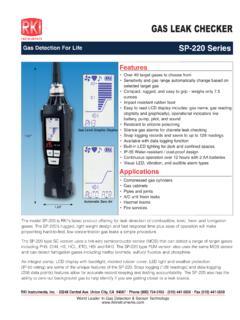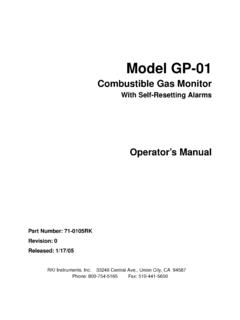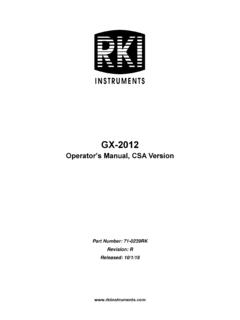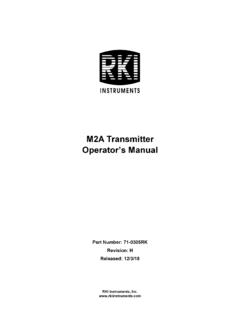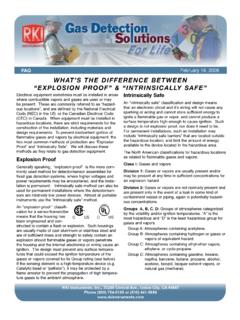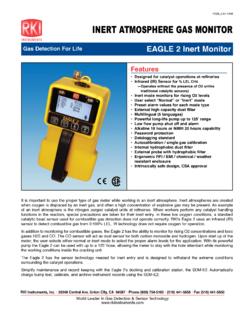Transcription of Operating Manual - RKI Gas Detectors
1 Portable Gas Monitor GX-8000. Operating Manual Part Number: 71-0390. Revision: P2. Released: 3/16/16. Request for the Customers Read and understand this Operating Manual before using this gas monitor. Use it in accordance with this Operating Manual . Regardless of warranty period, we shall not make any indemnification for accidents and damage caused by using this gas monitor. Make sure to read the warranty policy specified on the warranty. Because this is a safety unit, a regular maintenance for every six months and daily maintenance must be performed. If any abnormality is found in the gas monitor, notify it to RKI immediately. (Visit our Web site to find your nearest RKI office.). Safety information The Portable Gas Monitor Model GX-8000 is a gas monitor designed to provide continuous exposure monitoring of combustible gas, oxygen (O2), toxic gas such as carbon monoxide (CO) and hydrogen sulfide (H2S) in hazardous environments.
2 The gas sample is sucked in by build-in micro pump. The battery can be selected either Li-ion battery or alkaline dry battery. Li-ion battery unit is called BUL-8000 and alkaline dry battery unit is called BUD-8000. The battery unit can be changed even by the end users. Specification for safety Ex ia C T4 Ga 1 G Ex ia C T4 Ga Ambient temperature range for use -20 C to +50 C. Ambient temperature range during battery charging 0 C to +40 C. Electrical data Power supply of Li-ion battery unit : BUL-8000. Two parallel connected Li-ion cells used in battery pack BP-8000 are from type Maxell INR18650PB1. Um=250V. Power supply of alkaline battery unit : BUD-8000. Powered by three series AA size alkaline batteries , model LR6 by TOSHIBA. Backup battery type CR1220 manufactured by Maxell. Certificate numbers IECEx Certificate number IECEx KEM ATEX Certificate number KEMA 10 ATEX 0085. List of standards IEC 60079-0 2011 EN60079-0:2012.
3 IEC 60079-11 2011 EN60079-11:2012. IEC 60079-26 2006 EN60079-26:2007. WARNING. Do not charge in hazardous location. Do not charge it except by genuine charger. Do not replace battery unit in hazardous location. Do not replace dry batteries in hazardous location. Do not attempt to disassemble or alter the instrument. Use only battery unit type BUD-8000 with three series connected Alkaline AA batteries, type LR6 manufactured by Toshiba, or use chargeable battery unit type BUL-8000. INST. No. 0 0 0 0 0 0 0 0 0 0 0. AB C D E. A: Manufacturing year (0-9). B: Manufacturing month (1-9,XYZ for ). C: Manufacturing lot D: Serial number E: Code of factory <Contents>. 1 Outline of the Product .. 2. 1-1. Preface .. 2. 1-2. Purpose of Use .. 2. 1-3. Definition of DANGER, WARNING, CAUTION, and NOTE .. 2. 2 Important Notices on 3. 2-1. Danger Cases .. 3. 2-2. Warning Cases .. 4. 2-3. Precautions .. 5. 3 Product Components .. 7. 3-1.
4 Main Unit and Standard Accessories .. 7. 3-2. Names and Functions for Each Part .. 8. 4 How to Use .. 11. 4-1. Before Using the Gas Monitor .. 11. 4-2. Preparation for Start-Up .. 11. 4-3. Basic Operating Procedures .. 16. 4-4. How to Start the Gas Monitor .. 17. 4-5. How to 19. 4-6. Modes .. 23. 4-7. Air Calibration Mode .. 24. 4-8. Display/Setting Mode .. 26. 4-9. How to Exit .. 33. 5 Operations and Functions .. 34. 5-1. Gas Alarm Activation .. 34. 5-2. Fault Alarm Activation .. 36. 5-3. Other 36. 6 Maintenance .. 37. 6-1. Maintenance Intervals and Items .. 37. 6-2. How to 38. 6-3. Parts Replacement .. 38. 7 Calibration Mode ..41. 7-1. Preparing for Calibration ..41. 7-2. Fresh Air Adjustment (AIR CAL) ..44. 7-3. Span Adjustment ..46. 7-4. High Concentration Combustible Gas Zero Adjustment (VOL Z. CAL) ..48. 8 Storage and Disposal .. 49. 8-1. Procedures to Store the Gas Monitor or Leave It for a Long Time .. 49. 8-2.
5 Procedures to Use the Gas Monitor Again .. 49. 8-3. Disposal of Products .. 50. 9 Troubleshooting .. 51. 10 Product Specifications .. 53. 10-1. List of Specifications .. 53. 10-2. List of Accessories .. 55. 11 Definition of Terms .. 56. -1- 1. Outline of the Product 1-1. Preface Thank you for choosing our portable gas monitor GX-8000. Please check that the model number of the product you purchased is included in the specifications on this Manual . This Manual explains how to use the gas monitor and its specifications. It contains information required for using the gas monitor properly. Not only the first-time users but also the users who have already used the product must read and understand the Operating Manual to enhance the knowledge and experience before using the gas monitor. 1-2. Purpose of Use This gas monitor is a multi gas type that enables simultaneous monitoring of all of the following five types of gases at the maximum: oxygen, combustible gases, and toxic gases (carbon monoxide and hydrogen sulfide) in the air and high-concentration combustible gases (vol%) in N2 and inert gases.
6 Detection results are not intended to guarantee life or safety in any way. The gas monitor comes in several types for different combinations of gases to be detected. Check the specifications of the gas monitor before use and conduct gas detection properly in accordance with purposes. (See the list of gases to be detected at the end of this Operating Manual .). In addition to this Operating Manual , an Operating Manual for the data logger management program (option). is available for the gas monitor. Contact RKI if it is needed. 1-3. Definition of DANGER, WARNING, CAUTION, and NOTE. DANGER This message indicates that improper handling may cause serious damage on life, health or assets. WARNING This message indicates that improper handling may cause serious damage on health or assets. CAUTION This message indicates that improper handling may cause minor damage on health or assets. NOTE This message indicates advice on handling.
7 -2- 2. Important Notices on Safety 2-1. Danger Cases DANGER. About explosion-proof Do not modify or change the circuit or structure, etc. When measuring the oxygen concentration, do not measure anything but a mixture of air and combustible gases or vapors and toxic gases. When using this gas monitor in a hazardous area, take the following countermeasures for preventing dangers resulting from electrostatic charges. (1) Wear anti-static clothes and conductive shoes (anti-static work shoes). (2) For indoor use, use the gas monitor while standing on a conductive work floor (with a leakage resistance of 10 M or less). The battery units that can be connected are the BUL-8000(G) (certificate number TC19437) or BUD-8000(G) (certificate number TC19438). The specifications of the gas monitor are as follows: Pump circuit: Allowable voltage of V, allowable current of A, and allowable power of 1138 mW. Combustible gas sensor circuit: Allowable voltage of V, allowable current of A, and allowable power of 853 mW.
8 Buzzer circuit: Allowable voltage of V, allowable current of A, and allowable power of 441 mW. Main circuit: Allowable voltage of V, allowable current of A, and allowable power of 733 mW. Backup circuit: VDC, 10 A. About use While conducting measurement in a manhole or confined space, do not lean over or look into the manhole or closed space. It may lead to dangers because oxygen-deficient air or other gases may blow out. Oxygen-deficient air or other gases may blow out from the gas exhausting outlet. Never inhale the air or gases. High-concentration (more than LEL) gases may blow out. Never use fire near the gas monitor. -3- 2-2. Warning Cases WARNING. Sampling point pressure The gas monitor is designed to draw gases around it under the atmospheric pressure. If excessive pressure is applied to the gas inlet and outlet (GAS IN, GAS OUT) of the gas monitor, detected gases may be leaked from its inside, thus leading to dangers.
9 Be sure that excessive pressure is not applied to the gas monitor while used. Do not connect the gas sampling hose directly to a location with a pressure higher than the atmospheric pressure. The internal piping system may be damaged. Handling of sensor Do not disassemble the electrochemical type sensor or galvanic cell type sensor because they contain electrolyte. Electrolyte may cause severe skin burns if it contacts skin, while it may cause blindness if it contacts eyes. If electrolyte is adhered on your clothes, that part on your clothes is discolored or its material is decomposed. If contact occurs, rinse the area immediately with a large quantity of water. Fresh air adjustment in atmosphere When the fresh air adjustment is performed in the atmosphere, check the atmosphere for freshness before beginning the adjustment. If other gases exist, the adjustment cannot be performed properly, thus leading to dangers when the gas leaks.
10 Response to gas alarm Issuance of a gas alarm indicates that there are extreme dangers. Take proper actions based on your judgment. Battery level check Before use, check that there remains sufficient battery power. When the gas monitor is used for the first time or is not used for a long period, the batteries may be exhausted. Either fully recharge the batteries or replace them with new ones before use. If a low battery voltage alarm occurs, gas detection cannot be conducted. If the alarm occurs during use, turn off the power and promptly recharge the batteries in a non-hazardous area. Others Do not throw the gas monitor into fire. Do not wash the gas monitor in a washing machine or ultrasonic cleaner. Do not block the buzzer sound opening. No alarm sound can be heard. Do not remove the battery unit while the power is ON. -4- 2-3. Precautions CAUTION. Do not use the gas monitor where it is exposed to oil, chemicals, etc.


